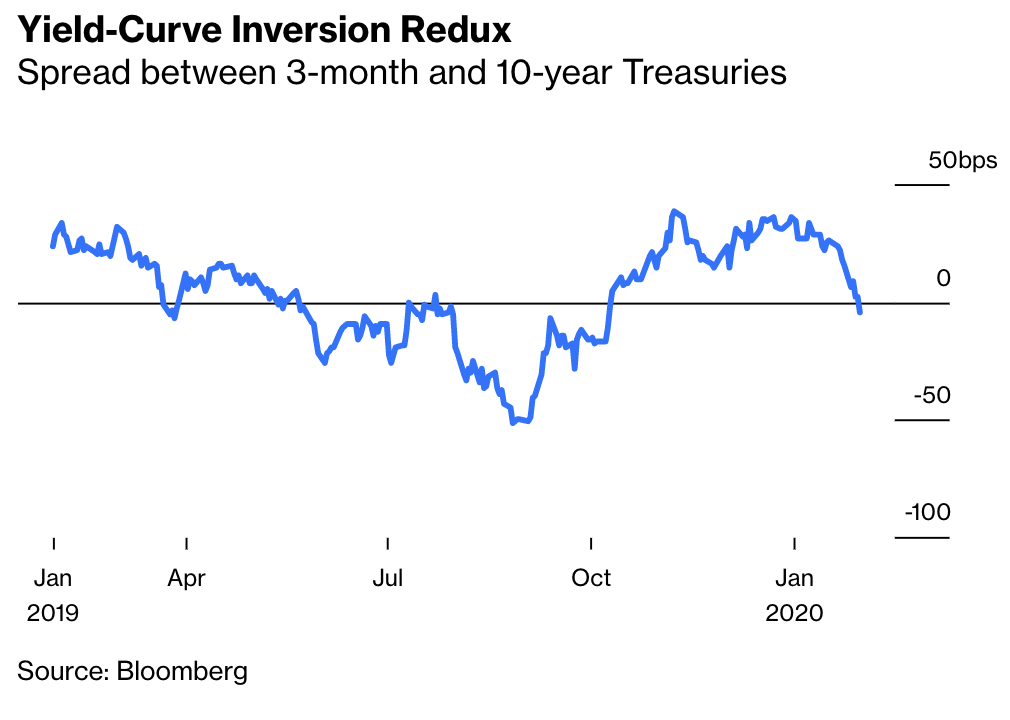Yield-Curve Inversion Is Sending a Message
The question is whether it’s saying anything meaningful about the odds of recession.
Bloomberg, February 3, 2020
The yield curve just inverted — again.
Driven by fears of a potential coronavirus pandemic that could cause widespread economic disruption, investment capital sought shelter in longer-term bonds. This flight to safety caused the curve to invert, at least for now.

The sages will tell you that yield-curve inversion is about as good a prognosticator of a coming recession as there is. But inversion first occurred back in March 2019, then briefly reversed, only to head back into inversion territory for much of the summer.
So far, we have avoided a recession and the economy continues to muddle along at an annual growth rate of a little more than 2%.
The most recent yield-curve inversion invites the question: What might trigger the next recession and what might it look like? Let’s look at a few things cited by pundits and commentators:
Geopolitical events: A recession triggered by geopolitical events is so random and highly variable that it’s almost impossible to see it coming — an escalation in the Middle East tensions sends oil prices spiraling; miscalculations in the South China Sea lead to open conflict; North Korea goes off its rocker.
Then there are the unforeseen random events such as the potential pandemic developing in China. We have no handle on how quickly this can spread, or how effective countermeasures will be to contain it. Fears from past outbreaks seem overblown in hindsight.
Although the odds are long that coronavirus leads to recession, similar events in the recent past have led to short-lived contractions that end once the initial shock wears off.
Odds of a Geopolitical Induced Recession: 15%
Tech Bubble: Gains in tech stocks have been driving equity markets higher for a decade. Concern that the broad market indexes would be dominated by a handful of giants have come to pass. Four U.S. tech companies — Apple, Alphabet (parent of Google), Amazon and Microsoft now have market capitalizations of $1 trillion or more. That was unfathomable even during the 1990s dot-com years.
Since it is requisite to add “and we know how that ended,” let’s look at how the dot-com bubble actually did end: The tech-laden Nasdaq Composite Index fell 78% while the broader S&P 500 index suffered a 49% fall. Despite the market carnage, the economic spillover was modest, with a modest eight-month recession from March to November 2001.
The key difference between then and now is valuations. At that time, some of the hottest tech companies had little revenue and no earnings. At the peak, the S&P 500 had a forward price-to-earnings ratio of 31; Nasdaq was closer to 70. The difference is that tech dominates today because it is so wildly profitable.
Tech stocks would indeed suffer during a recession, but there’s not really much to suggest that valuations are spiraling out of control. In other words, it’s hard to see how a tech bust itself will be the source of the next recession.
Odds of a Bubble Induced Recession: 10%
Federal Reserve: The unemployment rate is 3.5%, the lowest in more than 50 years. Companies eventually will find that they have trouble hiring workers and turn to pay increases to either lure people away from competitors or entice marginally attached workers back into the labor force.
It is not hard to guess how that progresses. As salaries rise, so too does consumer spending. The increased demand for services and durable goods leads to an increase in prices. The inflationistas, despite being wildly wrong for the past three decades or so, begin once again to sound alarms.
The Fed raises rates, calling it an insurance policy against higher prices. It has no effect, so it raises rates again with the same results. Finally, 18 months and 150 basis points later, the impact on credit availability and cost is noticeable. This cuts into earnings, leading to layoffs and reduced business investment, which already is in the doldrums. The economy suffers a modest contraction.
Back in the fourth quarter of 2018, recession anxiety after the Fed raised rates seven times in 2017 and 2018 sent stocks into a free fall. There was also concern about rising trade tensions between the U.S. and China, increasing market volatility and a host of other issues. Although the yield curve didn’t invert at the time, there was plenty of chin-striking by experts confidently predicting recession, which as we now know has yet to materialize. Of course, it might have helped that the Fed switched from raising rates to cutting them in 2019, lowering them three times.
Odds of a Federal Reserve Induced Recession: 60%
One note to add: Investing into the teeth of recent prior recession fears, however, turned out to be great timing: If you bought at the low-point of the market slump in December 2018, you were rewarded with a 31% return during the next four quarters.
One of these days, the U.S. will have a recession. Let’s hope you have your investment playbook ready — and the courage to use it to your advantage — when the next economic downturn comes along.
~~~
I originally published this at Bloomberg, February 3, 2020. All of my Bloomberg columns can be found here and here.

